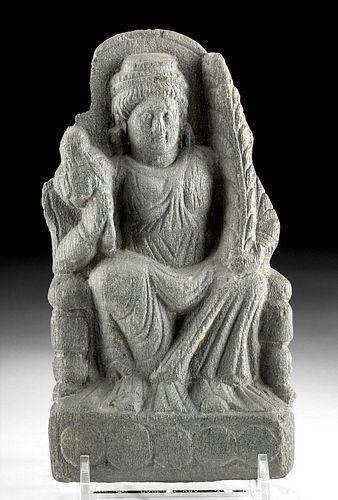3rd C. Gandharan Schist Relief Goddess Hariti
Lot 53a
About Seller
Artemis Fine Arts
686 S Taylor Ave, Ste 106
Louisville, CO 80027
United States
Selling antiquities, ancient and ethnographic art online since 1993, Artemis Gallery specializes in Classical Antiquities (Egyptian, Greek, Roman, Near Eastern), Asian, Pre-Columbian, African / Tribal / Oceanographic art. Our extensive inventory includes pottery, stone, metal, wood, glass and textil...Read more
Estimate:
$1,500 - $2,000
Absentee vs Live bid
Two ways to bid:
- Leave a max absentee bid and the platform will bid on your behalf up to your maximum bid during the live auction.
- Bid live during the auction and your bids will be submitted real-time to the auctioneer.
Bid Increments
| Price | Bid Increment |
|---|---|
| $0 | $25 |
| $300 | $50 |
| $1,000 | $100 |
| $2,000 | $250 |
| $5,000 | $500 |
| $10,000 | $1,000 |
| $20,000 | $2,500 |
| $50,000 | $5,000 |
| $100,000 | $10,000 |
| $200,000 | $20,000 |
About Auction
By Artemis Fine Arts
Jan 21, 2021
Set Reminder
2021-01-21 10:00:00
2021-01-21 10:00:00
America/New_York
Bidsquare
Bidsquare : Ancient / Ethnographic From Around The World
https://www.bidsquare.com/auctions/artemis-gallery/ancient-ethnographic-from-around-the-world-6316
Ancient art from Egypt, Greece, Italy and the Near East, as well as Asian, Pre-Columbian, Native American, African / Tribal / Oceanic, Spanish Colonial, Russian Icons, Fine art, much more! All categories, all price ranges... all legally acquired and guaranteed to be as described or your money back. Artemis Fine Arts info@artemisgallery.com
Ancient art from Egypt, Greece, Italy and the Near East, as well as Asian, Pre-Columbian, Native American, African / Tribal / Oceanic, Spanish Colonial, Russian Icons, Fine art, much more! All categories, all price ranges... all legally acquired and guaranteed to be as described or your money back. Artemis Fine Arts info@artemisgallery.com
- Lot Description
Central Asia, Pakistan, Taxila region, Gandharan, Kushan period, ca. 3rd century CE. A striking hand-carved grey schist high relief depicting the goddess Hariti dressed in a belted toga and seated on a throne. Adorned with bangles, a collared necklace, a flat-topped tiered tiara, and dangling earrings, the deity holds a pomegranate in her right hand and wheat in her left as she calmly looks outward toward the viewer from almond eyes over a flat nose and small closed mouth. Both of her feet rest below her on a dais decorated with five circles. Deposits of mica in the schist create a beautiful sparkling effect throughout the sculpture. Note the fine attention to drapery of her toga; a classical stylistic quality inherited from Alexander the Great's conquest of Gandhara in 330 BCE. Hariti's iconographic likeness to the Greek goddess Tyche via her wheat, pomegranate, and flat topped crown is further indicative of the Greek influence on the region. A rare example of Greco-Buddhist art that demonstrates a strong syncretism between eastern and western traditions. Stand for photography purposes only. Size: 3.75" L x 1.125" W x 6.75" H (9.5 cm x 2.9 cm x 17.1 cm)
According to Buddhist mythology, Hariti had hundreds of children whom she adored. However, in order to feed them, she kidnapped and slaughtered other children. When the grieving mothers asked Buddha to put an end to Hariti's actions, he abducted her youngest son and hid him under his rice bowl. After a desperate search, Hariti appealed to Buddha, who explained that her suffering was due to the loss of only one of her hundreds of children. He asked her to imagine the immense suffering of the parents who lost their only children. Upon hearing this, Hariti vowed to be a devout protector of children as well as women in childbirth. In return the Buddha gifted her with bodhi which empowered her to counter evil and cure the sick. From that moment on, she ate pomegranates, like the one pictured here, instead of human flesh.
Provenance: ex Estate of Eldert Bontekoe, Pegasi Numismatics, Ann Arbor, Michigan USA acquired before 2000
All items legal to buy/sell under U.S. Statute covering cultural patrimony Code 2600, CHAPTER 14, and are guaranteed to be as described or your money back.
A Certificate of Authenticity will accompany all winning bids.
We ship worldwide and handle all shipping in-house for your convenience.
#160124Fragment of a larger piece. Collection label on back. Expected surface wear with nicks/chips to periphery and nose, as well as a stable hairline fissure on the dais. Very light softening of detail on face, as commensurate with age. Otherwise, excellent with lovely earthen deposits in recessed areas.Condition
- Shipping Info
-
All shipping is handled in-house for your convenience. Your invoice from Artemis Gallery will include shipping calculation instructions. If in doubt, please inquire BEFORE bidding for estimated shipping costs for individual items.
-
- Buyer's Premium



 EUR
EUR CAD
CAD AUD
AUD GBP
GBP MXN
MXN HKD
HKD CNY
CNY MYR
MYR SEK
SEK SGD
SGD CHF
CHF THB
THB














